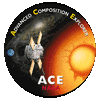

One of the most curious phenomena occuring during impulsive solar flares is the enrichment of the accelerated particle flux by some ion species. The most striking example is the 3He to 4He ratio that can increase by a factor of 104. Relative abandances of the heavy elements such as O, Si, and Fe also increase though less dramatically. Some gradual flares are characterized by unusually high Fe abundances at the initial stage as well. The observational situation in the field has significantly improved with the launch of the ACE satellite that has on board several instruments, most importantly SEPICA, measuring the spectra and composition of solar particles. This proposal is to request funding for a three-year program of research on the elemental and isotopic abundances and spectra of ions in impulsive and some gradual flares. Combined with the data from ULEIS, SIS, and CELIAS STOF on SOHO, the SEPICA data are ideally suited for testing the existing models for ion acceleration in flares as well as for developing more advanced theories. The extreme selectivity of the acceleration mechanism suggests that its understanding could provide significant insights into flare physics. The proposed projects include:
The study will emphasize analytical methods as well as comparisons
between theoretical predictions and observations. Overall, the work is
intended to be a step towards a unified modeling of global magnetic energy
release and charged particle acceleration in flares.
Our Email Address: asc@srl.caltech.edu